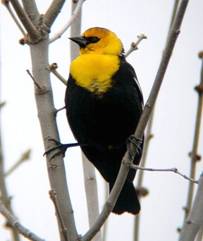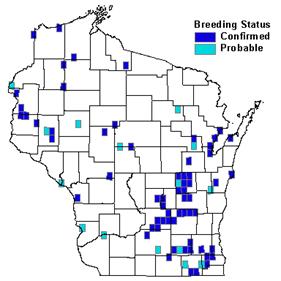Photo by Ryan Brady


Status/Protection
- Global Rank: G5 Key to global and state ranks
- State Rank: S4B
- WBCI Priority: PIF
Population Information
The Federal BBS information can be obtained at http://www.mbr-pwrc.usgs.gov/bbs/bbs.html by clicking on Trend Estimates and selecting the species in question. All estimates are for time period (1966-2005).
- Federal Breeding Bird Survey: non-significant increase
- Federal Breeding Bird Survey (WI): non-significant decline
- Federal Breeding Bird Survey (BCR 23): non-significant decline
- Federal Breeding Bird Survey (BCR 12): non-significant decline
- WSO Checklist Project: declining (1983-2007)
Life History
- Breeding Range: Central British Columbia south to California and east to southwestern Ontario, Wisconsin, and Illinois (Twedt and Crawford 1995).
- Breeding Habitat: Emergent Marsh.
- Nest: Open cup; usually attached to bulrushes, cattails, and reeds (Twedt and Crawford 1995).
- Nesting Dates: Eggs: mid-May to early July (Robbins 1991).
- Foraging: Ground glean, foliage glean, hawks (Ehrlich et al. 1988).
- Migrant Status: Short-distance migrant, Neotropical migrant.
- Habitat use during Migration: Emergent Marsh, Row Crop, Small Grains, Grassland-shrub.
- Arrival Dates: Mid-April to late May (Robbins 1991).
- Departure Dates: Early August to mid-October (Robbins 1991).
- Winter Range: Southern U.S. to southern Mexico (Twedt and Crawford 1995).
- Winter Habitat: Similar to breeding habitat.
Habitat Selection
The Yellow-headed Blackbird breeds in deep-water marshes, sloughs, forested wetlands, and along lake edges (Twedt and Crawford 1995). In Wisconsin they are most common in open, lowland marshes (Volkert 2006). They are colonial nesters with colony sizes in Wisconsin varying from several to >100 pairs (Robbins 1991, Volkert 2006). Nests are attached to cattails, bulrushes, or reeds above deeper water, ranging from 16-76 cm in Wisconsin. Competitive interactions with Red-winged Blackbirds typically result in Red-wingeds being forced into marsh edge habitats containing shallower water (Minock and Watson 1983). Yellow-headed Blackbirds forage within wetlands and surrounding open agricultural and upland areas (Twedt and Crawford 1995).
Habitat Availability
Prior to Euro-American settlement, wetlands occupied an estimated four million hectares of the total fourteen million hectares of Wisconsin’s land area. Today, 53% (2.1 million hectares) of these wetland habitats remain. However, agricultural drainage and urban development threaten remaining wetland ecosystems and local populations of wetland-associated birds. Human activities that alter hydrology and introduce invasive plant species also threaten wetland habitats (WDNR 2003). Strict wetland use regulations and incentive programs designed to restore or enhance wetlands have helped to curb habitat loss and protect existing wetlands (WDNR 1995).
Population Concerns
Historical evidence in Wisconsin indicates dynamic population trends throughout the twentieth century (Ellarson 1950). The Yellow-headed Blackbird is considered a fairly common summer resident in south and central Wisconsin, and an uncommon summer resident in the north (Robbins 1991). Its localized distribution makes it a difficult species to survey by conventional methods. Breeding Bird Survey (BBS) data suggest a non-significant population increase range-wide and non-significant decline in Wisconsin (Sauer et al. 2005). However, BBS methodology may not provide adequate coverage at colony sites. Wisconsin Breeding Bird Atlas observers visited colony sites from 1995-2000 and confirmed breeding activity in approximately 6% of the surveyed quads. Atlas observers estimated that 40 blocks had 2-10 breeding pairs, 26 blocks had 11-100 pairs, and 5 blocks had >100 pairs (Volkert 2006).
The drainage of marshes has led to the disappearance of colonies in the state (Volkert 2006), but also has resulted in geographic isolation of the Wisconsin population. Wisconsin is at the eastern edge of the Yellow-headed Blackbird’s breeding range. Thus, without connectivity of wetlands, the migration corridor is compromised and recruitment to the population is likely reduced (Ward 2005). Furthermore, the colonial nature of Yellow-headed Blackbirds makes them vulnerable to local extinctions. Events such as lethal control for crop depredation may have devastating consequences to local breeding populations if applied at colony or roost sites (Twedt and Crawford 1995).
Recommended Management
Management efforts should focus on preserving all existing emergent deep-water wetlands, but particularly those harboring breeding colonies. At colony sites, managers should consider maintaining water depth at 30 cm or more (Minock and Watson 1983) and promoting the growth of tall, robust emergent vegetation such as cattail and hard-stem bulrush. The continuation of wetland management, protection, and restoration efforts such as the Wetlands Reserve Program, Partners for Fish and Wildlife, and North American Wetland Conservation Act will benefit this species. Wetland restoration efforts should target areas in Wisconsin and surrounding states that will increase connectivity and re-establish a migratory corridor (Ward 2005).
Research Needs
More information is needed on habitat use, range, and behavior during winter (Twedt and Crawford 1995). In Wisconsin, targeted surveys in suitable wetland habitats would help to elucidate its status in the state. The absence of colonies in apparently suitable habitat needs further study (Minock and Watson 1983). At known Wisconsin colony sites, studies documenting recruitment rate, reproductive success, and adult survival would help to identify limiting factors.
Information Sources
- Cornell Lab of Ornithology species account: http://www.birds.cornell.edu/AllAboutBirds/BirdGuide/Yellow-headed_Blackbird.html
- Nicolet National Forest Bird survey map: http://www.uwgb.edu/birds/nnf/species/YHBL.htm
- North American Breeding Bird Survey: http://www.mbr-pwrc.usgs.gov/bbs/bbs.html
- Patuxent Bird Identification Center: http://www.mbr-pwrc.usgs.gov/id/framlst/i4970id.html
- Temple S.A., J.R. Cary, and R. Rolley. 1997. Wisconsin Birds: A Seasonal and Geographical Guide. Wisconsin Society of Ornithology and Wisconsin Department of Natural Resources, Madison, WI.
- Wisconsin Breeding Bird Atlas: http://www.uwgb.edu/birds/wbba/
References
- Ehrlich, P.R., D.S. Dobkin, and D. Wheye. 1988. The birders handbook: a field guide to the natural history of North American birds. Simon & Schuster, Inc. New York.
- Ellarson, R.S. 1950. The Yellow-headed Blackbird in Wisconsin. Passenger Pigeon 12: 99–109.
- Minock, M.E. and J.R. Watson. 1983. Red-winged and Yellow-headed Blackbird nesting habitat in a Wisconsin marsh. Journal of Field Ornithology 54: 324–326.
- Robbins, S.D., Jr. 1991. Wisconsin birdlife: population and distribution past and present. Madison, WI: Univ. Wisconsin Press.
- Sauer, J.R., J.E. Hines, and J. Fallon. 2005. The North American Breeding Bird Survey, Results and Analysis 1966 - 2005. Version 6.2.2006. USGS Patuxent Wildlife Research Center, Laurel, MD.
- Twedt, D.J. and R.J. Crawford. Yellow-headed Blackbird (Xanthocephalus xanthocephalus). In The Birds of North America, No. 509, (A. Poole and F. Gill, eds.). The Birds of North America, Inc. Philadelphia, PA.
- Volkert, W. 2006. Yellow-headed Blackbird. In Atlas of the Breeding Birds of Wisconsin. (N.J. Cutright, B.R. Harriman, and R.W. Howe, eds.) The Wisconsin Society for Ornithology, Inc. 602pp.
- Ward, M.P. 2005. The role of immigration in the decline of an isolated migratory bird population. Conservation Biology 19(5): 1528-1536.
- Wisconsin Department of Natural Resources (WDNR). 1995. Wisconsin’s Biodiversity as a Management Issue. http://dnr.wi.gov/org/land/er/biodiversity/report.htm
- Wisconsin Department of Natural Resources (WDNR) Wetland Management Team. 2003. Reversing the loss: A strategy for protecting and restoring wetlands in Wisconsin. Wisconsin Department of Natural Resources, Madison, WI. http://dnr.wi.gov/org/water/fhp/wetlands/documents/reversing.pdf
Contact Information
- Compiler: Kim Kreitinger, K.Kreitinger@gmail.com
- Editor: Andy Paulios, Andy.Paulios@Wisconsin.gov
